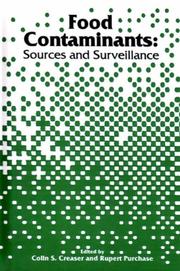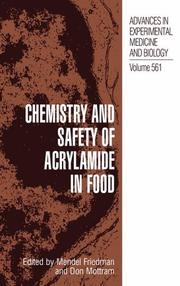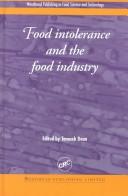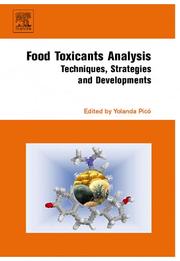| Listing 1 - 10 of 10 |
Sort by
|
Book
ISBN: 9781629483443 1629483443 1629483397 9781629483399 Year: 2013 Publisher: New York
Abstract | Keywords | Export | Availability | Bookmark
 Loading...
Loading...Choose an application
- Reference Manager
- EndNote
- RefWorks (Direct export to RefWorks)
Chemicals --- Food --- Food toxicology --- Nutritional toxicology --- Toxicology --- Nutritionally induced diseases --- Safety measures. --- Toxicology.
Book
ISBN: 0128223618 012822360X 9780128223611 9780128223604 Year: 2021 Publisher: London, England : Academic Press,
Abstract | Keywords | Export | Availability | Bookmark
 Loading...
Loading...Choose an application
- Reference Manager
- EndNote
- RefWorks (Direct export to RefWorks)
Food --- Toxicology. --- Food toxicology --- Nutritional toxicology --- Toxicology --- Nutritionally induced diseases --- Forensic Toxicology --- toxicity --- Toxicology, Forensic

ISBN: 9781845698287 1845698282 1855737841 9781855737846 Year: 2004 Publisher: Cambridge, England : Woodhead Publishing,
Abstract | Keywords | Export | Availability | Bookmark
 Loading...
Loading...Choose an application
- Reference Manager
- EndNote
- RefWorks (Direct export to RefWorks)
This book contains contributions based on the proceedings of two symposia on food contamination held in London in April 1989 and May 1990, both of which were organised jointly by the Environment, Food Chemistry and Toxicology Groups of the Royal Society of Chemistry. The aim of these meetings was to assess the extraneous chemical contamination of food from two sources: firstly, food-chain contaminants - the presence of plant toxicants of fungal metabolites in food, or the contamination of food from environmental sources (airborne, aquatic and terrestrial); and secondly, food-production contami
Food contamination. --- Food --- Toxicology --- Nutritionally induced diseases --- Food toxicology --- Nutritional toxicology --- Contamination (Technology) --- Food adulteration and inspection --- Contaminated food --- Foods, Contaminated --- Toxicology. --- Contamination
Book
ISBN: 1283034204 9786613034205 1555815936 9781683671312 1683671317 9781555815936 9781555814595 155581459X Year: 2010 Publisher: Washington, DC
Abstract | Keywords | Export | Availability | Bookmark
 Loading...
Loading...Choose an application
- Reference Manager
- EndNote
- RefWorks (Direct export to RefWorks)
Pathogens and Toxins in Foods offers a farm-to-table approach to food safety that helps readers understand the characteristics of specific pathogens and toxins, the illnesses they cause, and the factors that affect their survival and growth in food products. The book explores the most recent advances in biological, chemical, and physical interventions to control food-borne hazards during preharvest, harvest, food processing, and in retail ready-to-eat foods and food service operations.
Food --- Food toxicology --- Nutritional toxicology --- Toxicology --- Nutritionally induced diseases --- Sanitary microbiology --- Microbiology. --- Toxicology. --- Bacteriology --- Food Microbiology. --- Food Contamination --- Food Handling. --- prevention & control. --- Food Microbiology --- Food contamination --- prevention and control --- prevention and control.

ISBN: 1280623845 9786610623846 038724980X 0387239200 1441936726 Year: 2005 Publisher: New York : Springer,
Abstract | Keywords | Export | Availability | Bookmark
 Loading...
Loading...Choose an application
- Reference Manager
- EndNote
- RefWorks (Direct export to RefWorks)
Reports that heat processing of foods induces the formation of acrylamide heightened interest in the chemistry, biochemistry, and safety of this compound. Acrylamide-induced neurotoxicity, reproductive toxicity, genotoxicity, and carcinogenicity are potential human health risks based on animal studies. Because exposure of humans to acrylamide can come from both external sources and the diet, there exists a need to develop a better understanding of its formation and distribution in food and its role in human health. To contribute to this effort, experts from eight countries have presented data on the chemistry, analysis, metabolism, pharmacology, and toxicology of acrylamide. Specifically covered are the following aspects: exposure from the environment and the diet; biomarkers of exposure; risk assessment; epidemiology; mechanism of formation in food; biological alkylation of amino acids, peptides, proteins, and DNA by acrylamide and its epoxide metabolite glycidamide; neurotoxicity, reproductive toxicity, and carcinogenicity; protection against adverse effects; and possible approaches to reducing levels in food. Cross-fertilization of ideas among several disciplines in which an interest in acrylamide has developed, including food science, pharmacology, toxicology, and medicine, will provide a better understanding of the chemistry and biology of acrylamide in food, and can lead to the development of food processes to decrease the acrylamide content of the diet.
Acrylamide --- Food --- Toxicology. --- Food toxicology --- Nutritional toxicology --- Toxicology --- Nutritionally induced diseases --- Acrylic amide --- Propenamide --- Propenoic acid amide --- Acrylates --- Amides --- Food science. --- Chemistry. --- Food Science. --- Chemistry/Food Science, general. --- Physical sciences --- Science --- Food technology --- Chemical engineering --- Food Technology. --- Food Sciences --- Technology, Food --- Food Science --- Science, Food --- Sciences, Food --- Nutritional Sciences
Book
ISSN: 18719295 ISBN: 9789086863266 9086863264 9086868770 9789086868773 Year: 2019 Volume: 7 Publisher: Wageningen
Abstract | Keywords | Export | Availability | Bookmark
 Loading...
Loading...Choose an application
- Reference Manager
- EndNote
- RefWorks (Direct export to RefWorks)
Food Contamination. --- Meat Products. --- Dairy Products. --- Veterinay drugs --- Drug Residues. --- Pesticide Residues. --- Body Burden. --- Aliments d'origine animale --- Aliments --- Viande --- Médicaments vétérinaires --- Polluants agricoles --- Contamination. --- Teneur en médicaments vétérinaires --- Food --- Food of animal origin --- Toxicology. --- Food toxicology --- Nutritional toxicology --- Toxicology --- Nutritionally induced diseases --- Food Contamination --- Meat Products --- Dairy Products --- Pesticide Residues

ISBN: 1280372354 9786610372355 0849308534 1591240670 1855734974 1855736349 9781591240679 9781855736344 9780849308536 9781855734975 9781280372353 Year: 2000 Publisher: Boca Raton : Cambridge, England : CRC Press ; Woodhead Pub.,
Abstract | Keywords | Export | Availability | Bookmark
 Loading...
Loading...Choose an application
- Reference Manager
- EndNote
- RefWorks (Direct export to RefWorks)
Food intolerance and the food industry approaches the issue of food intolerance from an industry rather than a clinical perspective. This unique book has become an indispensable guide for production managers and nutritionists within the food industry as well as providing an authoritative source of information for all those concerned with understanding and managing food intolerance.Clear and concise explanations of complex medical informationFull coverage of the implications of the Food Safety Act 1990 and the Consumer Protection ActDetailed information on the
Food allergy. --- Food --- Nutritionally induced diseases. --- Toxicology. --- Diet --- Diet and disease --- Dietary causes of disease --- Diseases --- Nutrition disorders --- Food toxicology --- Nutritional toxicology --- Toxicology --- Nutritionally induced diseases --- Allergy --- Adverse effects --- Dietary aspects --- Causes and theories of causation --- Engineering --- Food Science and Technology

ISBN: 9780444528438 0444528431 9780080468013 0080468012 1280747250 9781280747250 9786610747252 6610747253 Year: 2007 Publisher: Amsterdam ; Boston, MA : Elsevier,
Abstract | Keywords | Export | Availability | Bookmark
 Loading...
Loading...Choose an application
- Reference Manager
- EndNote
- RefWorks (Direct export to RefWorks)
Food Toxicants Analysis covers different aspects from the field of analytical food toxicology including emerging analytical techniques and applications to detect food allergens, genetically modified organisms, and novel ingredients (including those of functional foods). Focus will be on natural toxins in food plants and animals, cancer modulating substances, microbial toxins in foods (algal, fungal, and bacterial) and all groups of contaminants (i.e., pesticides), persistent organic pollutants, metals, packaging materials, hormones and animal drug residues. The first section describes t
Food --- Food contamination. --- Food toxicology --- Nutritional toxicology --- Toxicology --- Nutritionally induced diseases --- Contaminated food --- Foods, Contaminated --- Contamination (Technology) --- Food adulteration and inspection --- Analysis of food --- Chemistry of food --- Food, Chemistry of --- Food chemistry --- Chemistry, Technical --- Sanitary chemistry --- Analysis. --- Toxicology. --- Contamination --- Chemistry --- Composition

ISBN: 1855737345 0849325587 9786610361588 1855739100 1280361581 1591249260 9781855737341 9781280361586 9781855739109 9780849325588 9781591249269 Year: 2004 Publisher: Boca Raton, FL : Cambridge : CRC Press [Chemical Rubber Company], Woodhead Publishing,
Abstract | Keywords | Export | Availability | Bookmark
 Loading...
Loading...Choose an application
- Reference Manager
- EndNote
- RefWorks (Direct export to RefWorks)
This wide-ranging text reviews the wealth of recent research on assessing and managing the risks from pesticide, veterinary and other chemical residues in food. After an introductory chapter on the key issues in food toxicology,Part one covers the assessment and management of risks, with individual chapters on genetic susceptibility to dietary carcinogens, good agricultural practice and HACCP systems, targeted and rapid methods for analysing residues in food and ways of assessing the mutagenicity of chemicals in food. Part two looks at veterinary residues, covering their safety, toxico
Feed additive residues --- Food contamination --- Food --- Nutritionally induced diseases --- Pesticide residues in food --- Veterinary drug residues --- Pesticide residues --- Pesticides --- Diet --- Diet and disease --- Dietary causes of disease --- Diseases --- Nutrition disorders --- Food toxicology --- Nutritional toxicology --- Toxicology --- Contaminated food --- Foods, Contaminated --- Contamination (Technology) --- Food adulteration and inspection --- Residues, Veterinary drug --- Residues, Feed additive --- Environmental aspects --- Adverse effects --- Dietary aspects --- Causes and theories of causation --- Contamination --- Engineering --- Food Science and Technology --- Food contamination. --- Toxicology. --- Drug residues --- Veterinary drug residues. --- Analysis.
Book
ISBN: 1299316433 0123914760 0124160417 9780124160415 9780124160415 9780123914767 9781299316430 Year: 2013 Publisher: Amsterdam Boston Elsevier/AP
Abstract | Keywords | Export | Availability | Bookmark
 Loading...
Loading...Choose an application
- Reference Manager
- EndNote
- RefWorks (Direct export to RefWorks)
The accelerated globalization of the food supply, coupled with toughening government standards, is putting global food production, distribution, and retail industries under a high-intensity spotlight. High-publicity cases about foodborne illnesses over recent years have heightened public awareness of food safety issues, and momentum has been building to find new ways to detect and identify foodborne pathogens and eliminate food-related infections and intoxications. This extensively revised 4e covers how the incidence and impact of foodborne diseases is determined, foodborne intoxications with
Food -- Microbiology. --- Food contamination. --- Food poisoning. --- Foodborne diseases. --- Foodborne diseases --- Food poisoning --- Food --- Environmental Pollution --- Parasitology --- Environmental Microbiology --- Poisoning --- Food Technology --- Food Safety --- Food Industry --- Biology --- Public Health --- Substance-Related Disorders --- Microbiology --- Diseases --- Environment and Public Health --- Industry --- Biological Science Disciplines --- Technology, Industry, and Agriculture --- Natural Science Disciplines --- Health Care --- Technology, Industry, Agriculture --- Disciplines and Occupations --- Food Microbiology --- Food Parasitology --- Food Contamination --- Foodborne Diseases --- Medicine --- Health & Biological Sciences --- Infectious Diseases --- Microbiology & Immunology --- Microbiology. --- Toxicology. --- Food toxicology --- Nutritional toxicology --- Food-borne diseases --- Foodborne illnesses --- Bacteriology --- Toxicology --- Nutritionally induced diseases --- Sanitary microbiology --- Communicable diseases
| Listing 1 - 10 of 10 |
Sort by
|

 Search
Search Feedback
Feedback About UniCat
About UniCat  Help
Help News
News